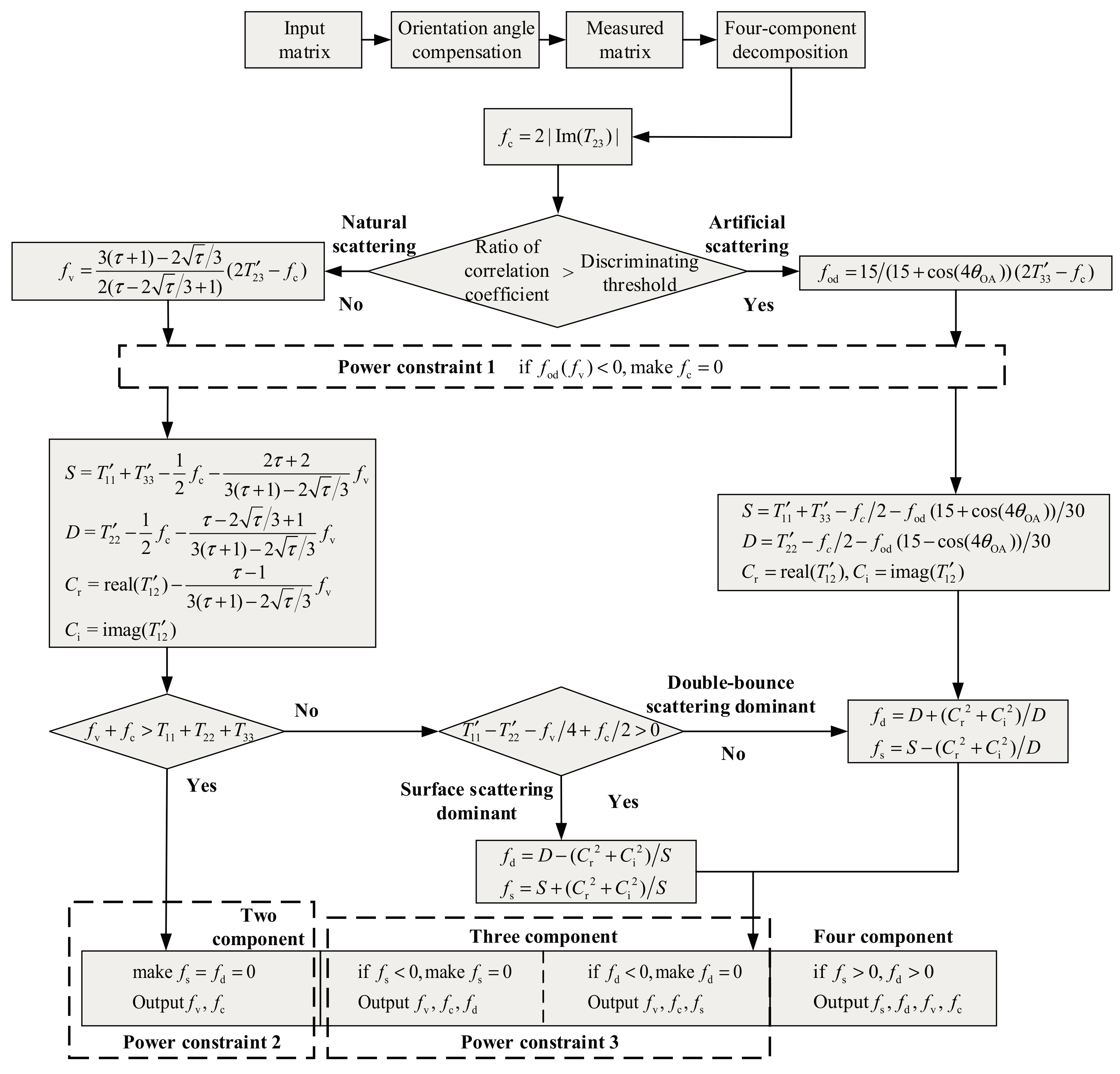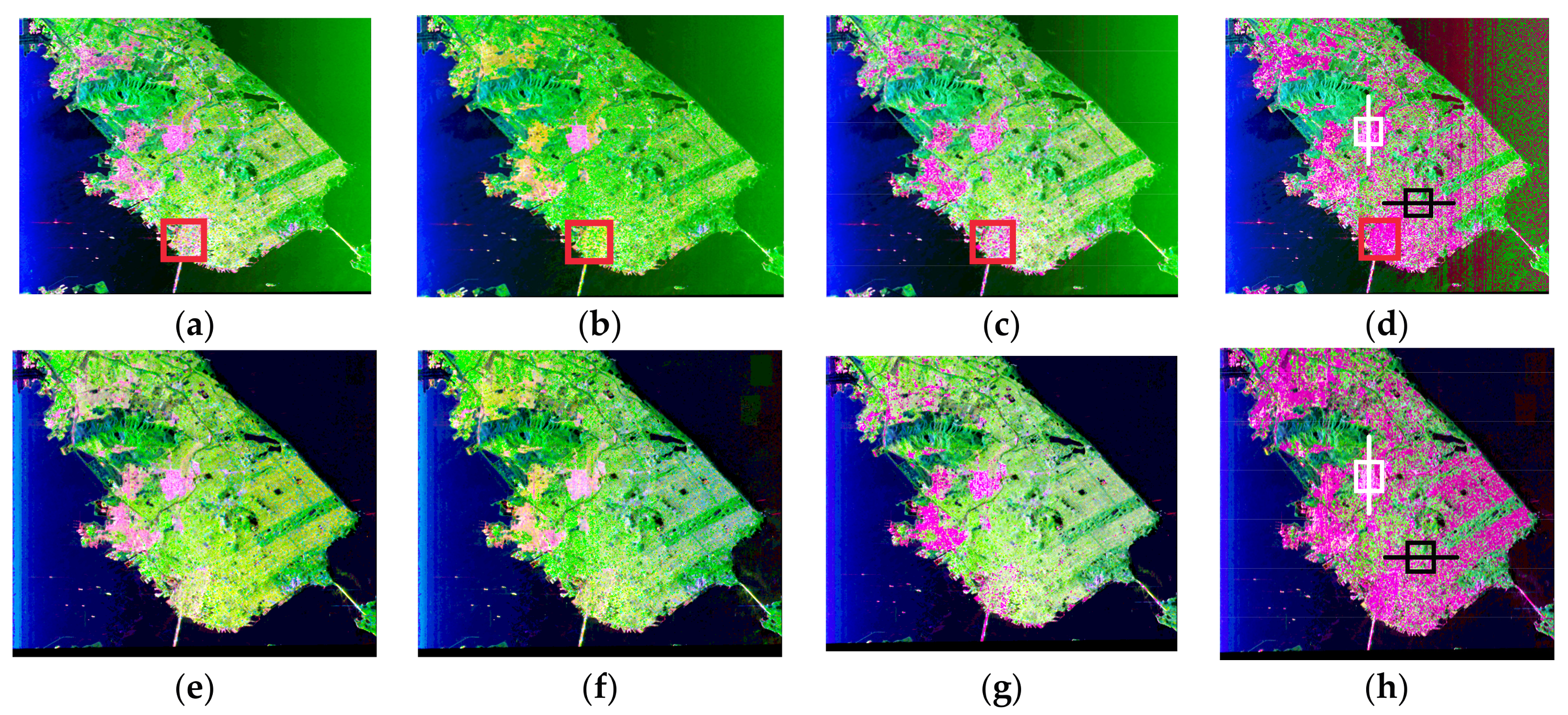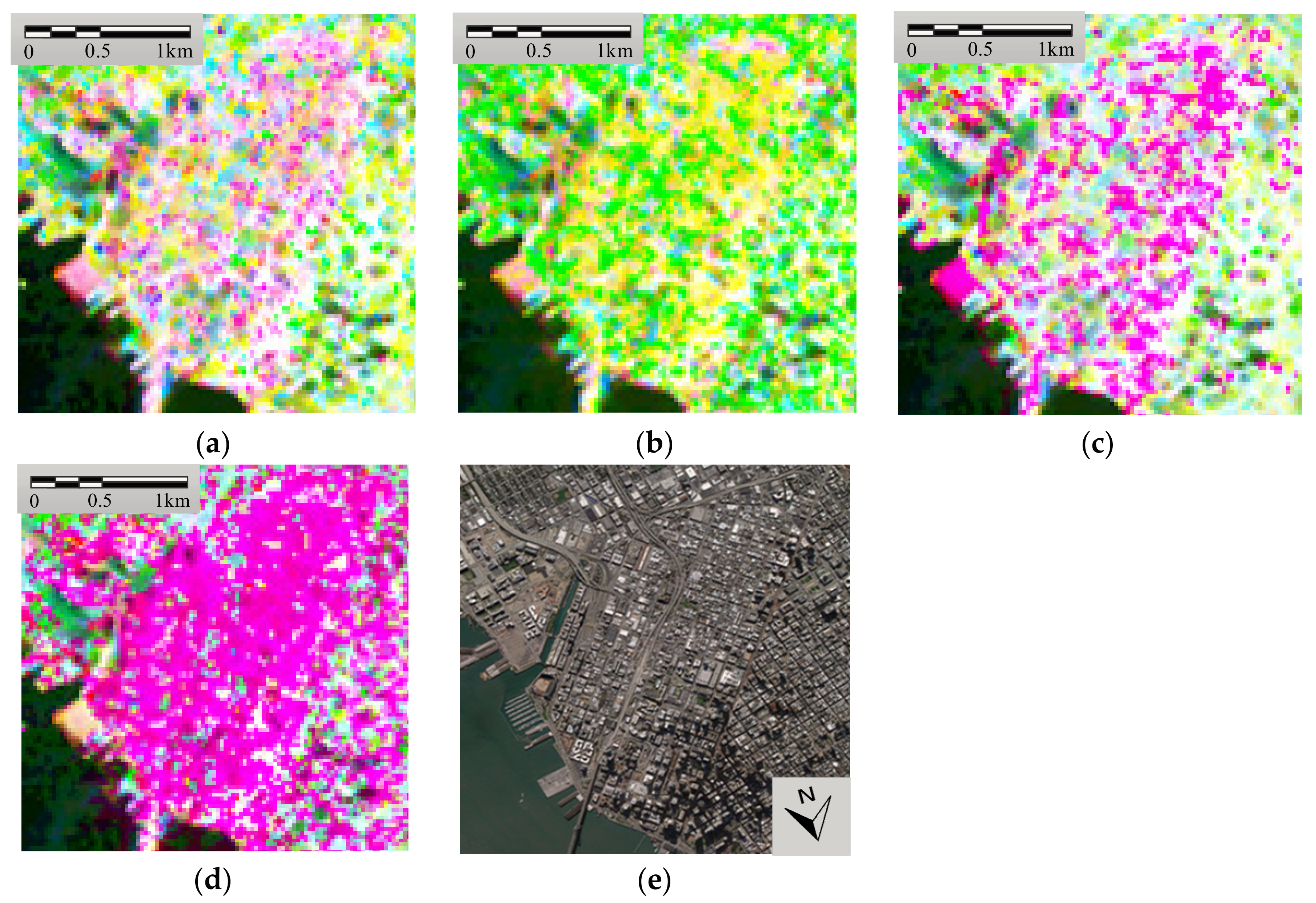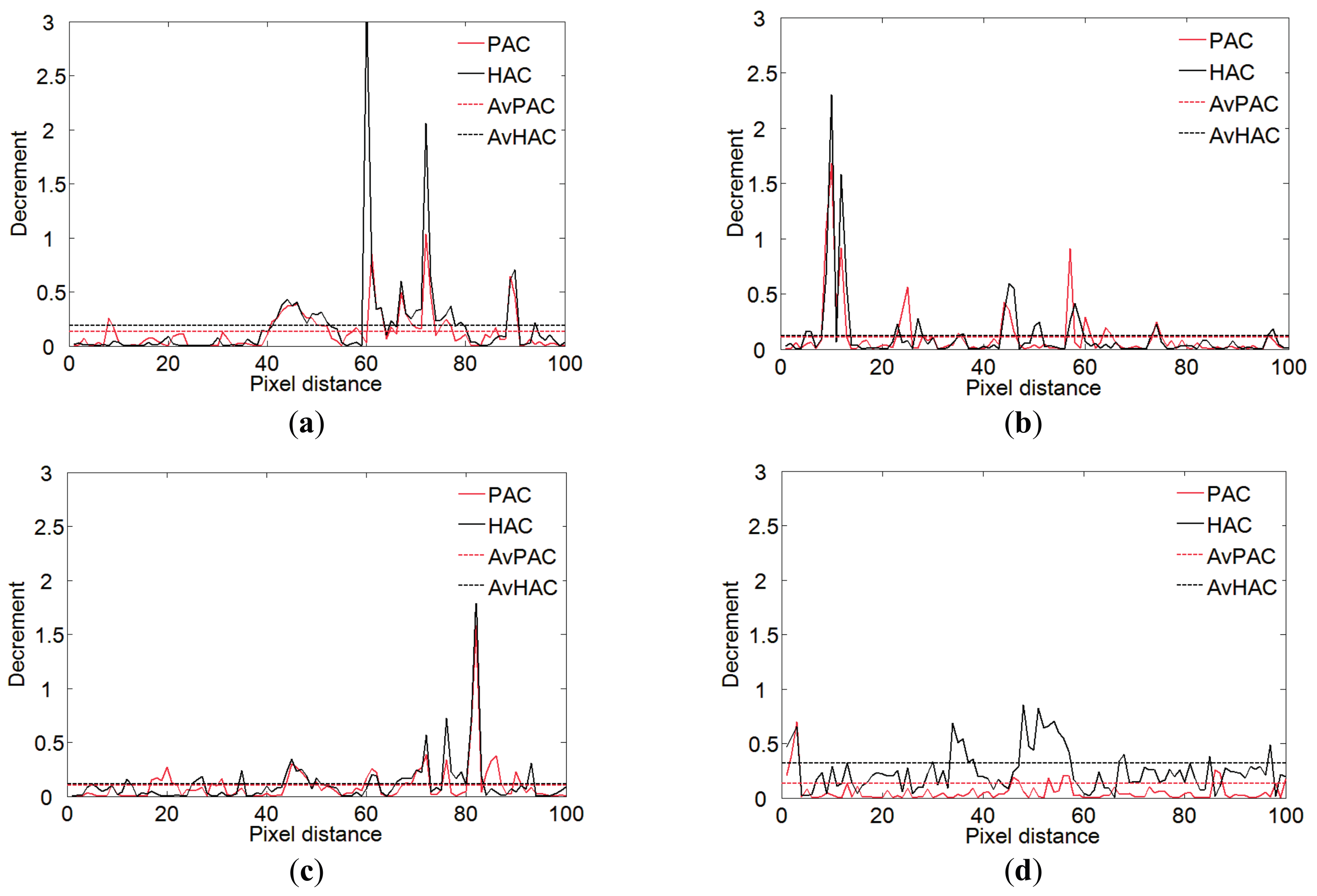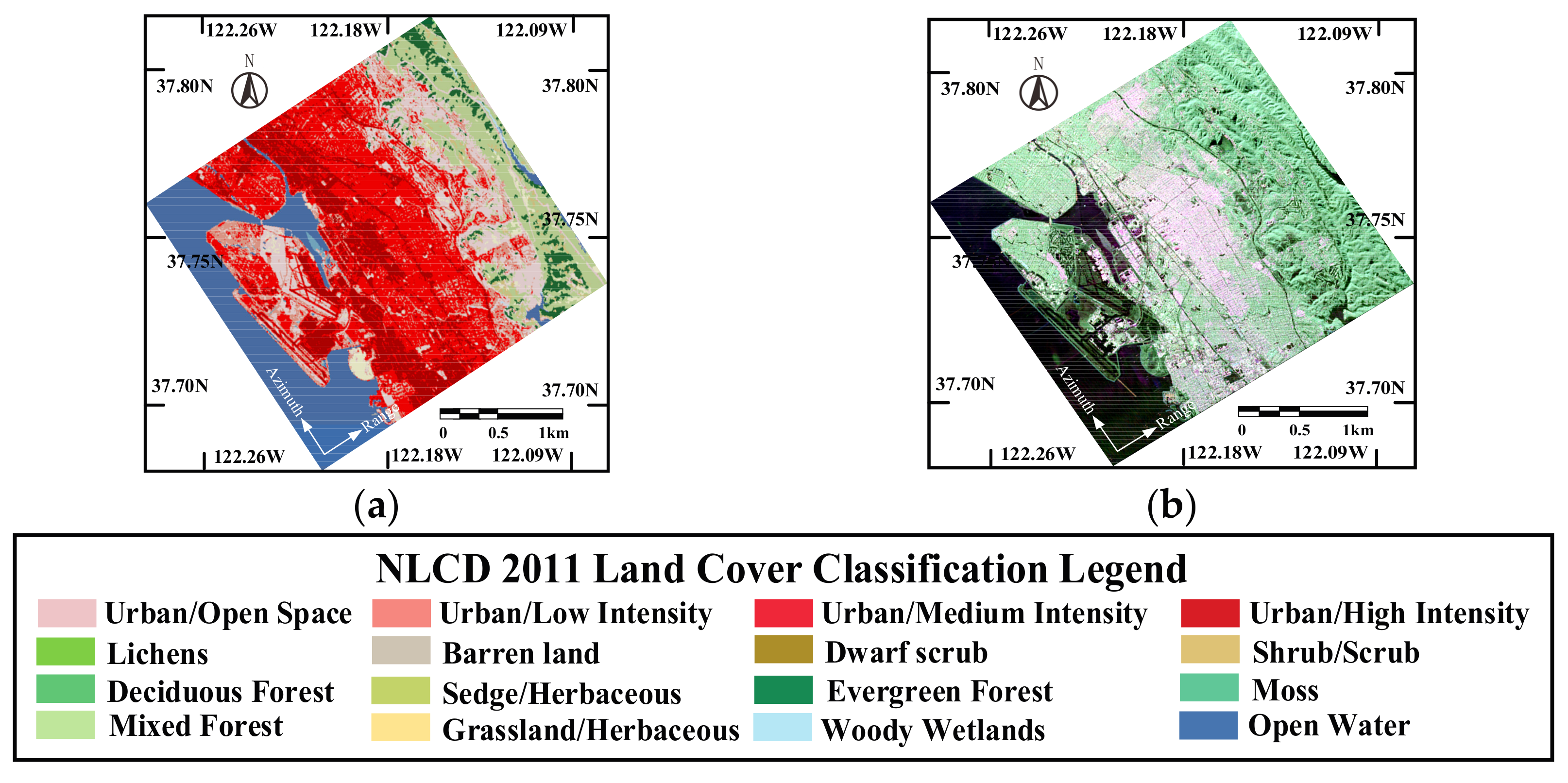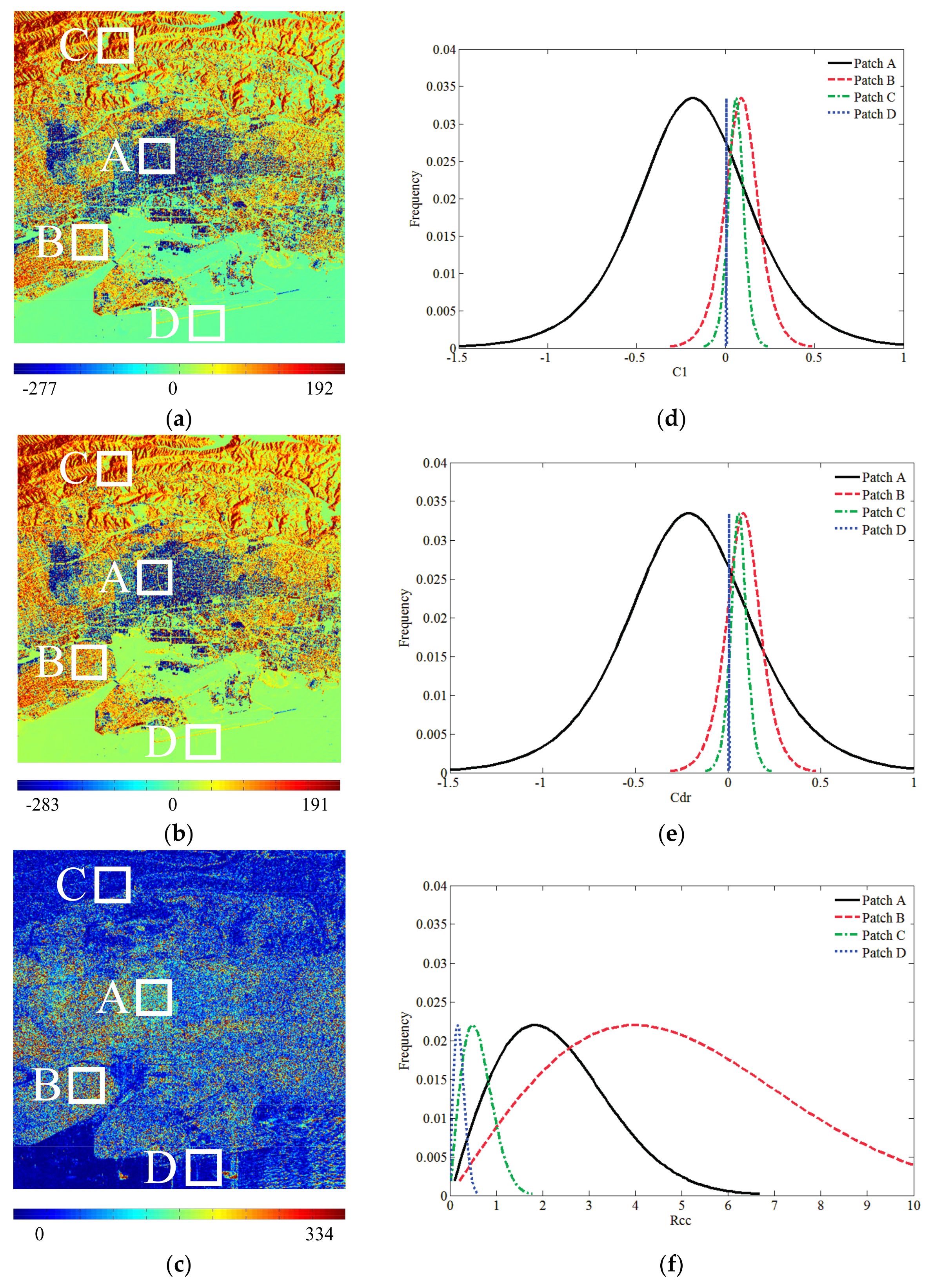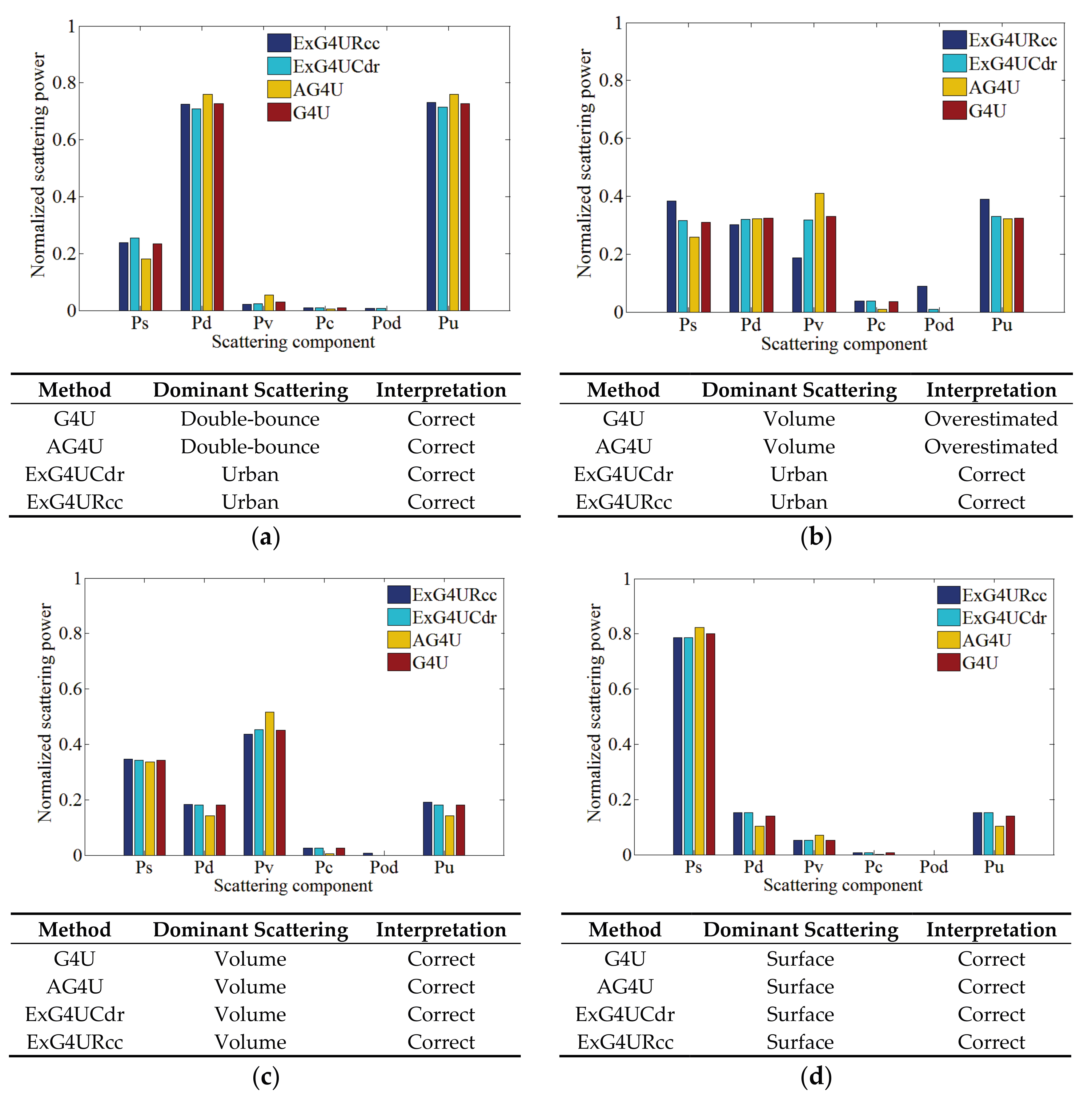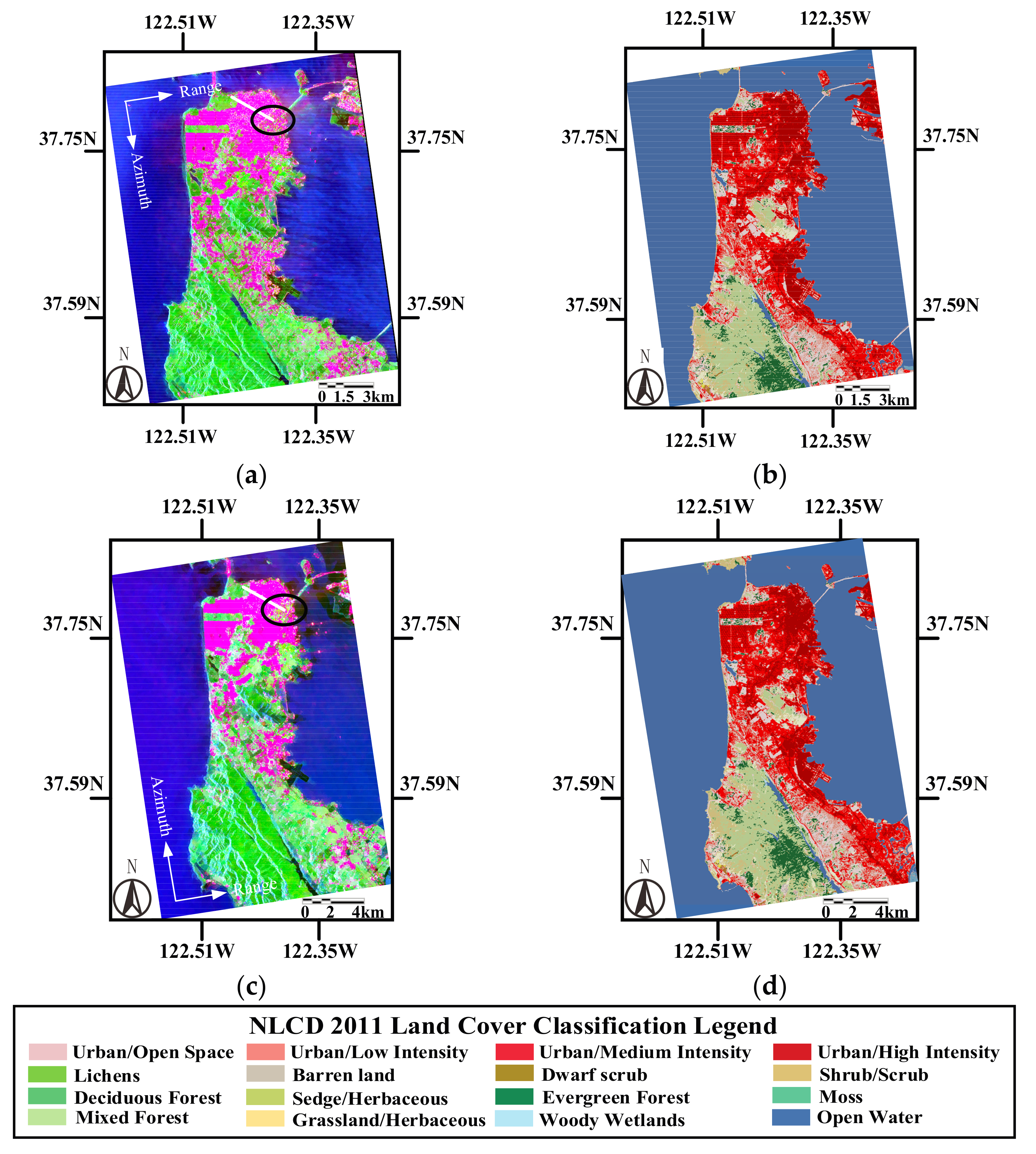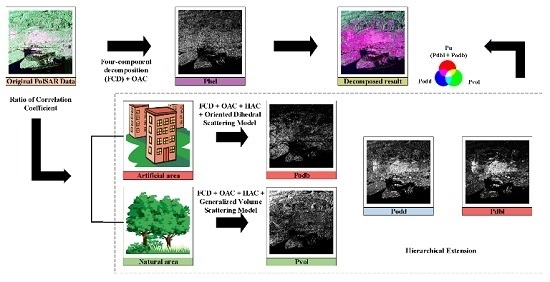The results reported here are derived from the Airborne Synthetic Aperture Radar (AIRSAR), Uninhabited Aerial Vehicle Synthetic Aperture Radar (UAVSAR), Radarsat-2, and the Advanced Land Observing Satellite (ALOS) Phased Array type L-band Synthetic Aperture Radar (PALSAR) polarimetric data acquired over different test sites in San Francisco and San Leandro, United States of America. Several polarimetric analysis techniques are employed.
5.3. Decomposition Results
The hierarchical extension of general four-component scattering power decomposition (ExG4URcc) developed in this paper is compared both qualitatively and quantitatively with three other approaches—the conventional G4U, the AG4U and the extended G4U (ExG4UCdr, with modifications of the HAC, the refined branch condition, and the oriented dihedral scattering model). All the output results are realized with the same image preprocessing procedure. Empirical power restrictions are used in evaluation of comparative performance of decompositions, and in case that either or is estimated to be negative, they are clipped to zero.
Qualitative Comparison: As an example, the color-coded representations of the G4U, AG4U, ExG4UCdr, and ExG4URcc methods are shown in
Figure 4, for which each color brightness corresponds to the magnitude. As expected, volume scattering is the dominating contribution in the total backscatter for vegetated areas. Backscatter for water areas is relatively small, and surface scattering is identified to be dominating for majority of the water pixels with regard to all of the methods. However, it can be seen that the decomposed result derived from the ExG4URcc seems redder, with oriented urban areas identified more clearly, as the level of volume scattering power decreased obviously for them. Moreover, the scattering power from artificial areas (including double bounce scattering power and oriented dihedral scattering power)
(red) is enhanced over urban areas and man-made structures with the ExG4URcc. Meanwhile, judging from vast areas in green tone, the OVS exists widely with regard to other methods. Among them, the ExG4UCdr provides redder results over oriented urban areas compared with the G4U and AG4U methods.
Quantitative Comparison in Different Land Covers: Two kinds of different land covers (see the white and black box areas in
Figure 4), including orthogonal urban areas and oriented urban areas are considered for the comparison. Scattering power contributions of
,
,
,
,
, and
are calculated and the relative scale of different scattering powers for these specific urban areas are shown in
Figure 5. Each pixel is normalized by the total power of the observation. The tables presented in the bottom indicate the dominant scattering interpreted by the G4U, AG4U, ExG4UCdr, and ExG4URcc methods.
For oriented urban areas, it is noted that
derived from the ExG4URcc dramatically enhanced compared with those from other methods for oriented urban areas. Specifically, the scattering power contribution from artificial areas (or the urban scattering power contribution) is increased from 29.9% (in the G4U) to 45.1%, and the oriented dihedral scattering power accounts for 10.1% of the total power, whereas the volume scattering power accounts for only 21.8% of the total power for C-band data. On the one hand, this suggests that the GVSM can appropriately estimate the contribution of volume scattering. On the other hand, it shows that the oriented dihedral scattering matrix can effectively model the cross-pol component from these highly oriented dense urban areas, which results in the occurrence of remarkable oriented dihedral scattering power
. Thus, the volume scattering power is significantly decreased with respect to the ExG4URcc. As a result, urban scattering masks volume scattering contribution for majority of these oriented urban pixels. Therefore, the scattering mechanism of the black box areas is identified as having the urban scattering mechanism as dominant. However, for the G4U, AG4U, and ExG4UCdr methods, the dominant scattering mechanisms of the black box areas are all regarded as volume scattering with regard to each waveband. For instance, their corresponding volume scattering powers are 0.517, 0.517, and 0.479 for L-band data, respectively. This indicates that these three methods still suffer the deficiency of the OVS as well as erroneous interpretation. In addition, notice that all of the lines almost coincide in the left column of
Figure 6. This indicates that similar decomposition results obtain as for orthogonal urban areas, as majority of pixels exhibits urban scattering behavior. As a result, the detailed quantitative comparisons will not be discussed for this land cover.
Figure 6 gives a more intuitive illustration that the urban scattering dominant characteristics are marked red. As previous mentioned, in contrast to the G4U and AG4U methods, more reddish results happen with the ExG4UCdr due to the increment of surface, double-bounce, and oriented dihedral scattering. This is reasonable since the red box areas are covered with buildings and streets. Consequently, the volume scattering obtained by the ExG4UCdr is not too overestimated, which is ascribed to the incorporation of the aforementioned modifications. Despite all of this, these modifications only lead to partial improvements in the results. Otherwise, the overestimation of volume scattering can be solved via the ExG4UCdr. Therefore, they are not the main sources of enhancement.
To further examine the scattering powers of the proposed method, the extent of scattering components’ change with different waveband data has been investigated. Since the objective is to ameliorate the overestimation of volume scattering, only oriented urban areas are involved. The corresponding normalized volume and oriented dihedral scattering power statistics are shown in
Table 3 and
Table 4. It is seen that the volume scattering power turns intense with the increase in wavelengths with the exception of the L-band result derived from the AG4U. The results of the two frequencies are probably related to the different relative weights of
and
, dictated by the different sensed relative roughness. In
Table 4, it can also be seen that the oriented dihedral scattering enhances as the wavelength increases with the ExG4URcc. A plausible explanation is that the induced cross-pol return is more intense when the lower frequency radiation acts on an oblique building. It is known that the differences between the G4U and ExG4UCdr methods are the HAC, the refined branch condition, and the oriented dihedral scattering model. In
Table 3, it can be seen that with the ExG4UCdr, the volume scattering power respectively decreases by 2.6% and 3.8% compared with the G4U. Meanwhile, the oriented dihedral scattering power respectively accounts for 0.9% and 0.6% of the total power. This demonstrates that the oriented dihedral scattering model make a partial contribution to the decrement of volume scattering power. The rest is benefit from the incorporation of the HAC and the refined branch condition. These two modifications will be discussed in the following.
5.4. Performance of the HAC
Without loss of generality, two lists of pixels (see the white and black lines in
Figure 4) are selected from the aforementioned urban areas to evaluate the performances of different angle compensations. Only the PAC and HAC are involved in the comparison since the OAC is applied beforehand. The decrements of the
term for the PAC and HAC are computed and shown in
Figure 7. The red and black dotted lines represent the averaged decrement of the
term for the PAC and HAC, respectively. Notice that the decrements for the PAC and HAC are quite small since the OAC already reduces a large amount of cross-pol power. Moreover, the
term continues to decrease via the PAC and HAC as long as the OAC is done correctly. It can be seen that the red dotted line is always beneath the black dotted line. Given this, we can conclude that the HAC advantages itself in reducing the
term compared with the PAC. This is one aspect of proving that the proposed method can effectively impair the volume scattering with the HAC.
Another concern associated with model-based decompositions is the occurrence of negative scattering powers. The occurrence of negative scattering powers generally happens to surface or double-bounce scattering since contributions of the volume or helix scattering are first estimated from the total measured data. The percentage of negative scattering powers has been investigated for two different circumstances: (1)
or
; and (2) both
and
. As seen in
Table 5 and
Table 6, the percentages of negative scattering powers have been reduced by 6.2% and 12.6%, respectively, from the G4U to the ExG4URcc under Circumstance (1), while, for Circumstance (2), there are decreases of 15.4% and 3.1% from the G4U to the ExG4URcc, respectively. This indicates that negative scattering powers are drastically reduced with the ExG4URcc. Furthermore, the ExG4URcc always achieves the minimum percentage of negative scattering powers for both of the wavebands. In addition, it is also known that the ExG4URcc performs better in reducing the negative scattering powers for L-band data since the percentages of negative scattering powers are the smallest for both of the circumstances (2.7% and 3.3%).
On the other hand, it is known that the HAC has better performance in the reduction of the term, which can actually bring about the relaxation of the OVS. Consequently, the volume scattering power can be constrained not to exceed the total power to a certain extent, thus lowering the chance that surface scattering power (or double-bounce scattering power) becomes negative. This inference can be confirmed from the total percentages obtained by the ExG4UCdr and ExG4URcc methods since the HAC is applied throughout the procedure (e.g., 7.3% and 6.0% for L-band data). Therefore, it is more inclined to employ the HAC instead of the PAC based on the above conclusion.
5.5. Comparison of Criteria
The second PolSAR data are acquired by UAVSAR over another test site in San Leandro, as shown in
Figure 8a, and have coverage of orthogonal and oriented buildings, and natural targets such as woods and ocean.
Figure 8b displays the fully polarimetric UAVSAR L-band data with Pauli color coding. The original PolSAR data are acquired on 20 November 2014 and have a resolution with 7.2 m in azimuth direction and 5 m in range direction.
In order to compare the performance of different criteria, we give the magnitudes of
,
, and
, as shown in the left column of
Figure 9. Four test patches corresponding to orthogonal buildings (A), oriented buildings (B), woods (C), and ocean (D) are selected from the magnitude images for evaluation. The fitting histograms of these areas are shown in the right column of
Figure 9. In
Figure 9f, it can be seen that
performs much better than other criteria since the magnitude difference between natural and artificial areas is apparent. The buildings in patch A and patch B exhibit much larger RCCs compared with other land covers, making them be easily discriminated from natural areas using the discriminating threshold. However, regards oriented buildings in
Figure 9d,e, they are mixed up with woods because of the similar magnitude values. In addition, notice that oriented buildings present more positive values in
and
. This implicates that they cannot be effectively distinguished using
or
. As discussed in the G4U, the assignment of cross-pol component depends on the sign of
. In fact,
only represents a special case of
which meets the condition of
. Hence, it is reasonable to deduce that
can be used to identify more pixels with double-bounce scattering.
To give a quantitative comparison, statistics of whole image pixels processed by these criteria are given in
Table 7. The size of the UAVSAR L-band image is 500 pixels × 500 pixels. It is seen that pixels processed by the RCC are approximately twice as many as those processed by
and
. This explains that the RCC is advantageous in discrimination of natural and artificial areas. In addition, the relationship of pixel numbers between
and
verifies the aforementioned deducing. As stated earlier, the HAC and the refined models are not the main sources of enhancement (recall the GVSM is only applied to natural areas), whereas, by integrating the RCC, hierarchical decompositions with the refined models are implemented, thus the overestimation problem can be overcome. Hence, the enhancement is mainly attributed to the introduction of the RCC. Despite all of this, it should be noted that the improvement is resulting from interactions among the modifications in the proposed method.
Figure 10 presents the decomposition results of the proposed method. In
Figure 10b, we can see that double-bounce scattering powers from orthogonal buildings are very strong, whereas those from buildings with large orientation angles are low. Meanwhile, oriented buildings have strong oriented dihedral scattering powers, as shown in
Figure 10d. Notice that some woods also have low oriented dihedral scattering powers. This is because double reflections from the ground-trunk combination can be identified due to the considerable penetration of L-band. In
Figure 10b,e, it can be found that the difference between double-bounce scattering and urban scattering is small. This suggests that oriented dihedral scattering is weak compared to double-bounce scattering.
Figure 10f shows the decomposed color-coded composite image. What we can see is that the red color of orthogonal buildings is brighter than that of oriented buildings. Even so, oriented urban areas still can be identified. This highlight of red color serves to interpret the dominant scattering mechanism of oriented urban areas more clearly.
To validate the performance of the ExG4URcc, the same patches (see the white box areas in
Figure 9) are selected from the scene for quantitative comparisons among other methods. In
Figure 11, we can see that for orthogonal buildings, woods, and ocean, the dominant scattering mechanisms are all correctly interpreted. Nevertheless, regards these three kinds of land covers, the volume scattering power derived from the ExG4URcc is always the smallest (e.g., 0.021, 0.437, and 0.052, respectively). This explains that the proposed method can effectively reduce the volume scattering, thus lowering the risk of the occurrence of the OVS. For oriented buildings, it can be seen that the volume scattering power is significantly smaller than the urban scattering power. Meanwhile the surface scattering component of the ExG4URcc is increased, as compared with those of other methods. In spite of this, the urban scattering is still larger than the surface scattering power. As a result, the dominant scattering mechanism of these areas is considered as urban scattering, which is conformity with the reality. However, for the G4U and AG4U methods, the results disclose the phenomenon that the volume scattering is still overestimated. It is worth noting that according to the magnitude relationship of the double-bounce and volume scattering powers (0.321 versus 0.318) derived from the ExG4UCdr, the dominant scattering mechanism can already be identified as urban scattering, let alone the existing oriented dihedral scattering powers. As mentioned above, the refined branch condition embedded in the ExG4UCdr plays a role in reducing the volume scattering. This indicates that the ExG4UCdr can also improve the OVS for some specific oriented urban areas.
5.6. Results with Spaceborne Data
Finally, we apply the proposed method to two sets of spaceborne data. These data are, respectively, acquired by Radarsat-2 and ALOS PALSAR over the same area in San Francisco. For estimating the coherency matrix, the multilook processing is performed in the preprocessing of the data. The final resolution is 23.7 m × 24.1 m and 21.2 m × 28.1 m in the ground area for Radarsat-2 and ALOS PALSAR images, respectively.
Based on the proposed decomposition, a color composite image showing the dominant scattering mechanism in each area is generated, as shown in
Figure 12. Still, the scattering component from artificial areas (red) contains contribution from both the double-bounce and oriented dihedral observations in the image. Overall, the ocean and airport runway areas are surface scattering dominant, while some coastal waters appear black due to specular reflection. The mountainous areas covered with forests are dominated by volume scattering. With the proposed method, improved performance is achieved especially in terrain consisting of oriented buildings (the black ellipse areas). As a result, the built-up areas are dominated by double-bounce or oriented dihedral scattering.
To further test the validity of the proposed approach, a transect shown in white line in
Figure 12 is made to show profiles of the decomposition power. This transect includes the park, orthogonal urban areas, and oriented urban areas. Therefore, land cover variation can be recognized. The values of the decomposed powers along the transect are calculated, resulting in
Figure 13. It reflects the status of each of the scattering mechanisms. From the inspection of
Figure 13, it can be see that the contribution of
agrees with the distribution of both orthogonal and oriented urban areas. However, one may find out that some pixels in oriented urban areas exhibit strong volume scattering from the tail end of these curves. This situation occurs due to the following two reasons. On the one hand, discriminations of oriented buildings are not so accurate since the discriminating threshold is empirically determined. One the other hand, the oriented dihedral scattering model is found to inappropriately characterize those buildings with smaller orientation angles. These remaining problems will be considered in the future study.

